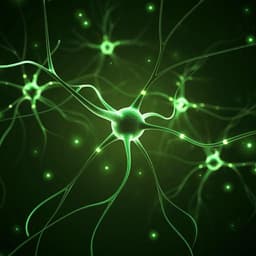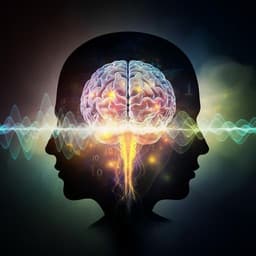
Psychology
Bifurcation in brain dynamics reveals a signature of conscious processing independent of report
C. Sergent, M. Corazzol, et al.
Explore the fascinating neural dynamics of conscious access revealed in this groundbreaking research by Claire Sergent and colleagues. Their analysis of EEG responses provides insights into how the brain processes auditory stimuli, even in the absence of tasks, shedding light on the very nature of consciousness itself.
~3 min • Beginner • English
Introduction
The study investigates whether there are neural signatures of conscious access that are independent of report-related decision processes. Prior work has contrasted neural activity for identical stimuli that are reported as perceived versus not perceived, revealing late sustained activity, wider network engagement, and increased connectivity. However, overt reporting may confound neural signatures with decision-making and motor preparation, and previous paradigms often involved complex visual stimuli and sharp transients. The authors aim to test for a general, report-independent neural signature of conscious processing in a simpler auditory paradigm, and to formally distinguish bifurcation dynamics (qualitative split between conscious and non-conscious processing) from unimodal non-linear dynamics using explicit computational models and analyses of inter-trial variability.
Literature Review
Prior studies on the neural correlates of conscious perception (e.g., attentional blink, visual masking) have shown sharp changes separating reported seen from missed trials, including all-or-none late evoked potentials beyond ~250 ms, non-linear increases around detection threshold, and evidence in infants and non-human primates. These findings suggest bifurcation-like neural dynamics. Nonetheless, questions remained about modality generalization beyond vision, the role of complex stimuli and stimulus transients, contamination from decision/motor processes in report, and whether previously observed non-linearities truly reflect bifurcations versus unimodal non-linear responses. Reviews have highlighted the need to generalize candidate signatures across modalities (including audition) and to employ formal dynamical modeling to avoid conflating non-linearity with bifurcation.
Methodology
Participants: 20 right-handed native French speakers (mean age 23.4, 10 women) completed both active (report) and passive (no auditory task) sessions; EEG recorded with 64 electrodes at 500 Hz. Order of sessions was counterbalanced. Ethics approval and informed consent obtained. Control experiments: (i) 10 naïve participants with passive session only (7 included after quality control); (ii) 5 participants with pure tone stimuli instead of vowels.
Stimuli: Two vowels (/a/ or /ə/), 200 ms duration, synthesized with MBROLA, presented in continuous Threshold Equalizing Noise (TEN). SNR levels around threshold: −13, −11, −9, −7, −5 dB (plus noise-only trials). For last 10 subjects in passive session, an additional −3 dB SNR. In tone control, two pure tones (1000 Hz and 2236.1 Hz), similar durations and SNR ranges adapted to threshold.
Tasks: Active session—two responses per trial: (1) 2-AFC vowel identification, (2) continuous audibility rating (0–10 scale). Passive session—no auditory task; after each stimulation period, one randomly selected probe/task: speeded visual response, mind-wandering probe (report content: sound/task/thoughts/nothing-sleepy), quiz, or click-to-continue. Mind-wandering probes used to capture spontaneous conscious contents.
Trial structure: Fixation; target onset 1–3 s after trial start (200 ms duration); response/probe screen 2–3 s after target. 960 trials per session (2 vowels × 6 levels × 80 reps), organized in 20 blocks (~7 min each). Continuous TEN throughout blocks.
EEG preprocessing: High-pass 0.4 Hz; notch at 50 Hz; bad electrodes interpolated; ICA for ocular artifacts; epoching −500 to +2000 ms relative to target onset (pseudo-onset for noise-only trials); artifact rejection; average reference; baseline correction. Low-pass filtering (10 Hz or 30 Hz) applied for specific analyses/visualization.
Analyses:
- Event-related potentials (ERPs): grand-averages and topographies; ROI analyses (centro-parietal for active; temporal for passive) computing mean and trial-to-trial variability across SNRs in selected time windows.
- Multivariate pattern analysis (MVPA): L2-regularized logistic regression classifiers trained to discriminate target-present (max SNR) vs target-absent, with 10-fold cross-validation; temporal generalization matrices (training at each time point, testing across times); projected activity (signed distance to decision boundary) used as continuous trial-wise neural measure; AUC computed vs chance.
- Behavioral: Psychometric identification performance and audibility ratings; distributional analyses and variability (SD) across SNRs.
- Modeling: Three neural dynamics models contrasted—(1) unimodal linear (illustrative), (2) unimodal non-linear (Gaussian with logistic mean vs SNR), (3) bifurcation (mixture of low-state at baseline and high-state with logistic dependence; mixing proportion logistic with SNR). A null model assumed no SNR effect. Models fit to trial-by-trial projected activity averaged in 30 ms windows using maximum likelihood with cross-validation. Group random-effects Bayesian model comparison to compute protected exceedance probabilities over time.
- Link to behavior: Compare distributions of projected activity vs model predictions; split trials by audibility (≥30% vs <30%); linear mixed-effects model to test Report × SNR interaction; time-resolved correlations between neural mean/variability profiles and behavioral audibility mean/variability profiles.
- Active vs passive: Cross-classification between sessions; source reconstruction (Brainstorm, OpenMEEG BEM, sLORETA) comparing −5 dB vs absent and active vs passive; ROIs included auditory/temporal cortex, inferior prefrontal cortex, and supplementary motor area.
- Prediction tasks: Using bifurcation model fits, compute trial-level Bayes Factors (BFs) for high vs low state to predict (i) active-session heard vs not-heard reports at intermediate SNRs, (ii) passive-session mind-wandering content (sound vs other).
Key Findings
- Behavioral evidence of bifurcation: Audibility variability (SD) across trials showed a non-monotonic profile with a prominent peak around detection threshold (−9 to −7 dB SNR). Audibility distributions near threshold were bimodal (modes near 0% and >50%). The variability peak was present in all 20 participants.
- ERP signatures: Classic auditory components (N1 ~150 ms, P2 250–500 ms, P300 500–900 ms) modulated by SNR. Mean neural activity increased non-linearly with SNR from early latencies, but only from ~250–300 ms did trial-to-trial variability become non-monotonic with a peak near threshold, consistent with bifurcation dynamics.
- MVPA: Significant stimulus-present vs absent decoding began ~100 ms and showed sustained generalization beyond 250 ms. Mean projected activity increased non-linearly with SNR after 150 ms (ANOVAs F(4,76)>4.9, p<0.005 FDR). Trial-to-trial variability transitioned from flat/monotonic (≤200 ms) to non-monotonic with peak around threshold from 200–250 ms onward; neural variability profiles significantly correlated with behavioral variability from 200–250 ms (t(19)=3.06, p=0.010, d=0.68) and strongly beyond 250 ms (t(19)>4.10, p<0.01, d>0.9).
- Bimodality and report linkage: Distributions of projected activity around threshold were bimodal, matching bifurcation model predictions. Splitting by audibility report revealed a significant Report × SNR interaction for 300–400 ms mean activity (LME: Report F=30.3, p=1.12×10^-5; SNR F=54.7, p=3.27×10^-7; Interaction F=7.86, p=0.011), consistent with the bifurcation model’s prediction that non-heard trials remain at baseline regardless of SNR, while heard trials scale with SNR.
- Time-resolved neuro-behavioral coupling: Mean profile correlations persisted from onset to >1.5 s; variability profile correlations emerged ~250 ms and lasted until ~700–800 ms, marking the bifurcation window.
- Bayesian model comparison: Before 250 ms, unimodal non-linear model best explained data; from ~250–700 ms, bifurcation model dominated with protected exceedance probability >95% across most of this window; after ~700–900 ms, unimodal model prevailed again.
- Decoding conscious report without labels: Using bifurcation model fits, trial-level BFs predicted heard vs not-heard with high accuracy between 250–700 ms (AUC > 0.75), without using behavioral labels for training.
- Active vs passive: In passive listening, the P3-like positivity vanished, but late sustained activity (to ~700 ms) persisted with different topography. Cross-classification showed that passive-trained decoders captured a substantial portion of active late activity (250–600 ms), and active-trained decoders fully captured passive late activity, indicating shared core conscious access processes augmented by decision components in active tasks.
- Source localization: Both sessions engaged a broad network beyond 250 ms including auditory/temporal and inferior prefrontal areas; active sessions uniquely recruited premotor/motor/SMA, consistent with decision/motor preparation.
- Passive-session bifurcation: Mean and variability profiles in passive sessions showed a variability burst for intermediate SNRs (shifted to higher SNRs, −7 to −5 dB) and correlated with active-session behavioral profiles (after accounting for SNR threshold shift).
- Predicting mind-wandering content: In passive sessions, bifurcation-based BFs predicted whether the sound was reported as current mind content, with above-chance AUCs between ~250–700 ms (approximately 0.6–0.65), indicating spontaneous conscious access to sounds can be inferred from neural activity alone.
- Generalization to tones: Control experiment with pure tones reproduced late sustained activity and bifurcation dynamics in both active and passive sessions, supporting modality-general mechanisms.
Discussion
The findings address the central question of whether conscious access has a neural signature independent of report-related decision processes. By focusing on inter-trial variability and explicit dynamical modeling, the study shows that around 250–700 ms post-stimulus, neural responses exhibit a bifurcation: identical stimuli produce either a high-activity state linked to awareness or a low-activity baseline state linked to lack of awareness. This bifurcation signature is present even without an auditory task or overt report and predicts subjective reports and spontaneous mind-wandering contents. Importantly, the analysis distinguishes early unimodal non-linear dynamics (preconscious processing ≤200–250 ms) from later bifurcation dynamics (conscious access). Cross-session decoding and source analyses suggest that report-free conscious access engages a widespread network overlapping with that engaged during report, minus frontal executive/motor components, clarifying the relation between the P300 and conscious access: P300 reflects decision-related processes overlapping with, but not constituting, the core access signature. Overall, results support and refine predictions of the global neuronal workspace theory by validating an ignition-like bifurcation while dissociating it from the P300 and decision stages. The approach offers a principled, label-free method to decode conscious access, with implications for basic science and clinical assessment of consciousness.
Conclusion
The study introduces a model-based, variability-focused framework to identify a robust neural signature of conscious access: a bifurcation in neural dynamics between 250–700 ms post-stimulus, evident as a burst in inter-trial variability and bimodal activity distributions near threshold. This signature generalizes to auditory modality, persists without report, predicts trial-wise awareness and mind-wandering contents, and is best explained by a bifurcation model in Bayesian comparisons. The work refines the global neuronal workspace account by separating core conscious access dynamics from decision-related P300 components and proposes a “global playground” active during task-free access that becomes a full global workspace under task demands. Future research should: (i) use spatially resolved methods (e.g., fMRI, intracranial recordings) to further map the network underlying covert conscious access; (ii) test generalization across more stimulus types and sensory modalities; (iii) adapt and validate the paradigm for clinical diagnostics in non-communicating patients; and (iv) integrate variability-based modeling with computational and causal perturbation approaches to probe mechanisms of ignition and access.
Limitations
- Source localization with EEG is spatially limited and susceptible to misattribution/spillover, particularly for frontal sources; fMRI or intracranial data are needed to confirm network involvement during passive access.
- Although session order was counterbalanced and controls with naïve passive-only subjects were included, subtle covert strategies cannot be entirely ruled out.
- Control experiments had small sample sizes (tones: n=5; passive-only: n=7 analyzed), limiting precision of generalization estimates.
- The paradigm focuses on auditory stimuli near threshold; while a tone control was positive, broader generalization across tasks, modalities, and populations remains to be established.
- MVPA and model fits depend on classifier choices and preprocessing; while cross-validation and FDR corrections were used, alternative pipelines could be explored for robustness.
Related Publications
Explore these studies to deepen your understanding of the subject.







